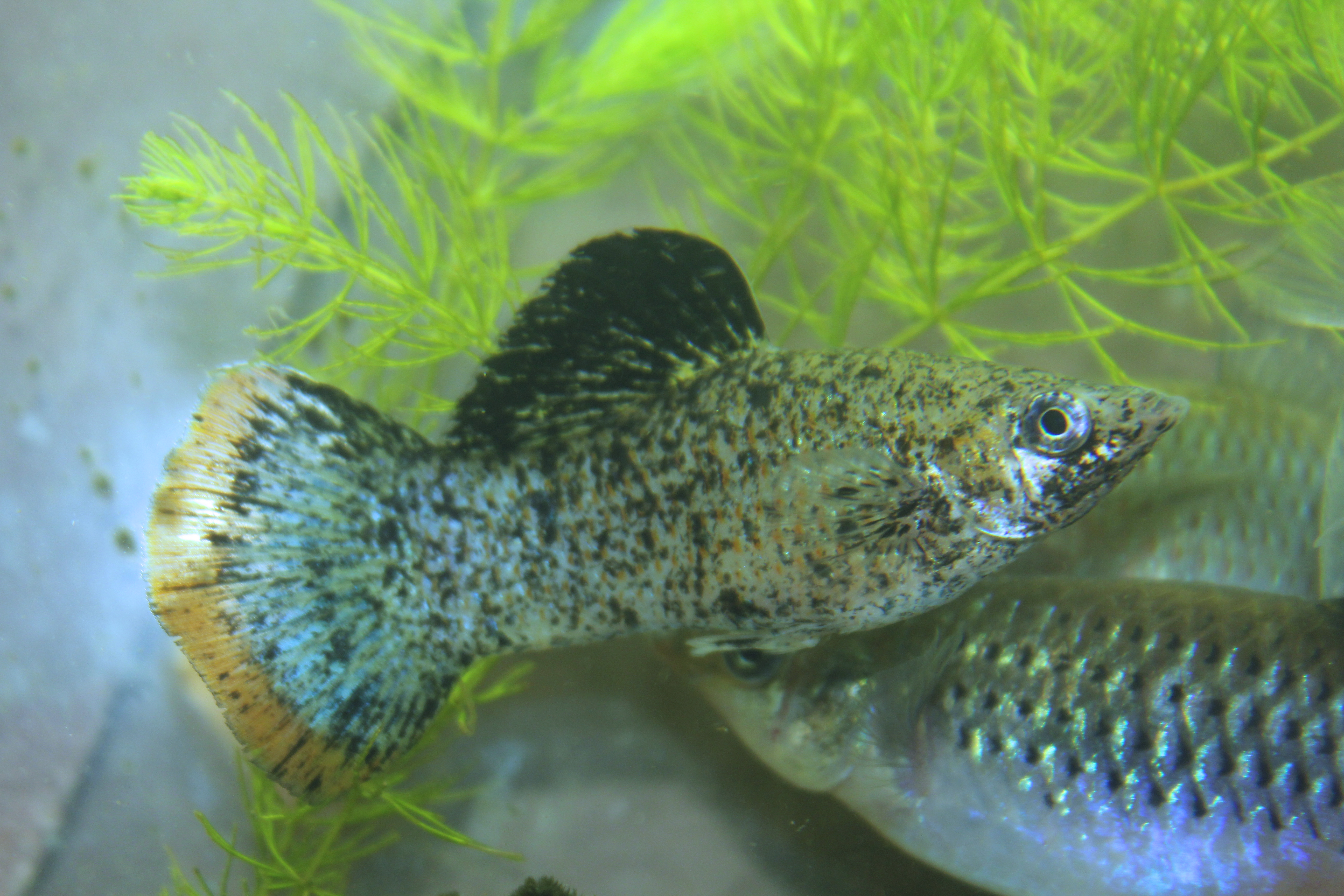Back in 2013 I set up a cross of Poecilia mexicana, Campeche males with P. velifera, Campeche females. I didn’t expect much from this cross because earlier matings between P. mexicana and P. velifera hadn’t produced anything spectacular, but I often keep trying despite lack of good results. Being busy with other fish, I pretty much forgot about them until June, 2014. By that time, their vat held the original female P. velifera and male P. mexicana along with 106 mature F1 hybrids and a mixture of about 400 F1s, F2s, and back crosses juveniles. The fry and juveniles are probably a mixture of F1, F2, and back cross fish, both fry and juveniles. Unexpectedly, the F1 fish were very nice so I saved the best of them as breeders. The fry and juveniles were set aside to see how they would look when mature.
The F1s had two phenotypes, marbled and non-marbled. The males of both types had powder blue bodies. Many of the females had blue highlights on their flanks. All were large, much closer in size to P. velifera than P. mexicana. The non-marbled males reminded me of large sized old liberty molly, hence the new name I gave them: Giant Liberty Molly. I called the marbled fish Giant Marble Liberty Mollies. You can see why I’d flunk marketing classes. Surely there are better names for these fish. The balance of this blog is about the Giant Marble Molly, although we also are working on the Giant Liberty Molly.
I separated the phenotypes and selected the three best males and 10 females as breeders. The remaining F1s and various F2s, F3s and back crosses were set up aside to grow up.
Today, we processed the two Giant Marble Liberty Molly vats. First, we sorted them into breeder sized fish and others. The others were placed in a vat to grow out as potential future breeders. The breeding sized fish were further sorted into breeders and non-breeders. The non-breeders weren’t bad fish; they were just not the absolute best. We ended up with three very large, very nice males and 22 large, pretty females and set up them up for breeding.
Since we expect this to be a popular fish when we release it, we’re setting it up on a normal livebearer production cycle. That means in about three months we’ll process both vats again. The juveniles will be moved to a third vat to grow out. The non-breeder adults will be culled of fish not meeting the type and the remainder will be placed in a sale vat. The best fish will become our new breeders. It will take a few more generations to set the strain and improve size and color. And, like all marble mollies, there will always be 5-10% of the fish that either aren’t marbled or are black and will be culled.


Chuck says
If the real color is that blue , you have a good format for your blue mollies. I really like the red on the tail. I could see where you could go several ways with this fish , if the genes cooperate. It’s exciting to still see new crosses hit the market.
chuck
Chuck says
Hi Charles,
I remember “Marble” mollies that were short finned and had tan or gold mixed in with the black and white back in the 1970’S . A lot of those mollies also had a red band on the trailing edge of their caudal fin. The traditional marble Mollie faded away when Dalmations became popular. Unfortunately so did the red band. It would be nice to see that band captured and redeveloped. I don’t think anyone has ever done that . It could be another direction that you could take this mutation.
Tim Gray says
Colors were beautiful, and the shape of the body and fins was outstanding.
Tim Gray says
Mr. Charles, is it possible to ‘create’ amazon mollies with the cross between mexicana and velifera that you used to produce the Giant Marble mollies? Similar or Identical to the amazon mollies supposedly created when latipinna and mexicana breed?
charles says
Tim,
I’ve made many crosses between the two putative parental species, Poecilia latipinna and P. mexicana and always have gotten equal numbers of male and female F1s. I’ve noticed no unequal sex ratios in subsequent generations. I can’t be absolutely certain that no P. formosa (Amazon molly) were produced, but if they had been, I would expect at some point to see a sex ratio skewed toward female. I probably should refer your question to Dr. Caitlin Gabor who has been studying P. formosa.
Charles
charles says
Tim,
I really like this fish and look forward to improving dorsal size and intensifying the colors.
Charles
Thomas Edwards says
👋🏽 Hello!
I was wondering if you had any mollies either wild or hybrid that you have culled or are soon to cull and might would be interested in selling?
To make it worth your while I would also purchase a pair of Texas Cichlids and a pair of Convict cichlids…….
Thomas Edwards says
Hello Goliad farms,
I really like the attention you give your fish and the environment you raise them in. I look forward seeing how your lines prove out and add new and better DNA in the hobby.